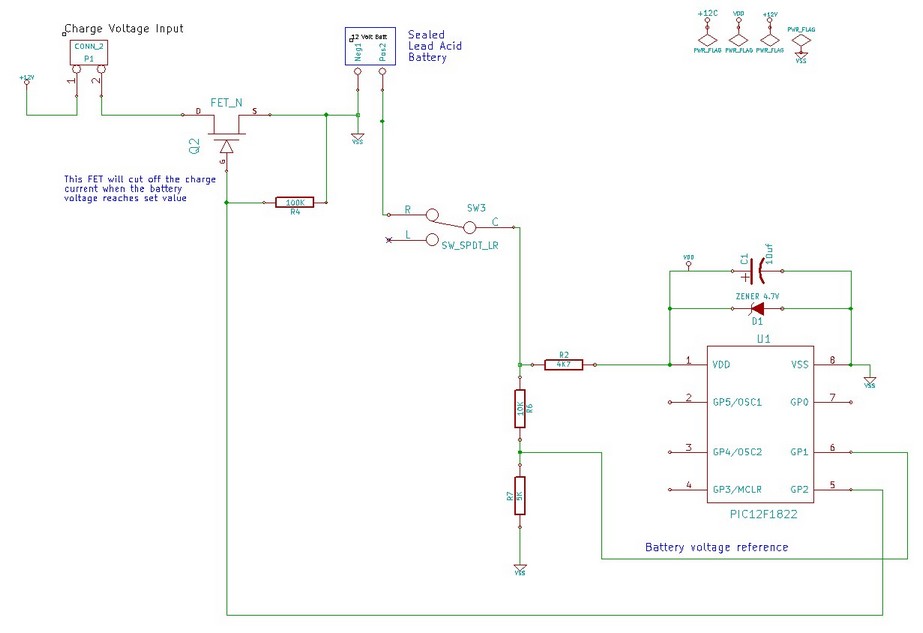My code below (using Darrels example to read VDD) is only displaying 65535 on my LCD???
This is on my breadboard with the PICkit2 supplying the 5vdc (4.87 measured w/voltmeter)
Any suggestions on why I am not seeing 4.87??
Code:
' Pic Configuration
' =================
#CONFIG
__CONFIG _CONFIG1, _FCMEN_OFF & _IESO_OFF & _BOREN_OFF & _FOSC_INTOSC & _WDTE_OFF & _MCLRE_OFF & _PWRTE_OFF
__CONFIG _CONFIG2, _LVP_OFF
#ENDCONFIG
' -----[ Initialization ]--------------------------------------------------
Reset:
DEFINE OSC 4
OSCCON = %01101010
TRISA = %001010 ' PortA.3 is button input, A.1 is a/d in
ANSELA = %0010 ' Turn on Analog for AN1 (PortA.1)
PORTA = 0 ' all outputs zero
CM1CON0.7 = 0 ' Disable comparator
CCP1CON = %00001100 ' CCP in PWM mode
APFCON = %00000001 ' Move PWM to PortA.5
ADCON0 = %00000111 'x,AN1,AD enabled
define adc_bits 10 'set up the a/d converter
define adc_clock 3
define adc_sampleus 50
'
' Software variables
' ==================
Duty VAR WORD
stepp var byte
Cmd CON $FE 'LCD prefix for Command
Clr con 1 'LCD CLEAR SCREEN
Hm con 2 'LCD HOME COMMAND
ADvalue var word
VDD var word
VDD_Res CON 10 ; A/D resolution (bits) used for VDD measurement
FVrefMV CON 1024 ; Fixed Vref Voltage in mV ( must match FVRCON )
Vref_AD5 CON EXT ; Calculate FVref A/D reading when VDD = 5.00V
@Vref_AD5 = (_FVrefMV*100000) / (500000000/(1023 << (_VDD_Res-10)))
' ----------------[ I/O Definitions ]-----------------------------------
LED var PortA.0 ' LED indicator
Chg VAR PORTA.2 ' FET to control charge current
Btn var PORTA.3 ' push button input
Light con 1 ' Constant for HPWM channel 1 PortA.5
' -----[ Program Code ]----------------------------------------------------
pAUSE 500
SEROUT2 4,16468,[$1b,$2a,64] 'Set LCD backlight (0-255)
pause 200
SEROUT2 4,16468,[Cmd,Clr] 'clear LCD
pause 100
Main:
SEROUT2 4,16468,[Cmd,Clr] 'clear LCD
pause 100
gosub getvdd
Serout2 4,16468,[dec vdd," ",$0d,$0a]
pause 500
goto main
;----[Get VDD by reading the FVR]-----------------------------------------------
GetVDD:
ADCON1 = %10110000 ; A/D Right Justified, FRC clock,VREF is VDD
FVRCON = %10000001 ; Enable Fixed Voltage Reference (1.024V)
WHILE !FVRCON.6 : WEND ; Wait for fixed ref to be stable
ADCIN 31, ADvalue ; Read the FVR channel
FVRCON = 0 ; Disable Fixed Voltage Reference
VDD = Vref_AD5 ; calculated Vref A/D at 5.00V
VDD = VDD * 500 ; * 500 - two decimal places
VDD = DIV32 ADvalue ; / FVRef reading - converts to VDD volts
RETURN
What I want to do is adapt this to read a 12V SLA (lead acid) battery that is also powering my PIC using a simple Zener Regulator(maybe not wise?)
How does one use the FVR to calibrate an external A/D reading of a 12v battery voltage via a resistor voltage divider??
My end goal is to have the PIC be able to cut off the charger when the battery reaches say 14.5 V for simple over charge protection.


















Bookmarks